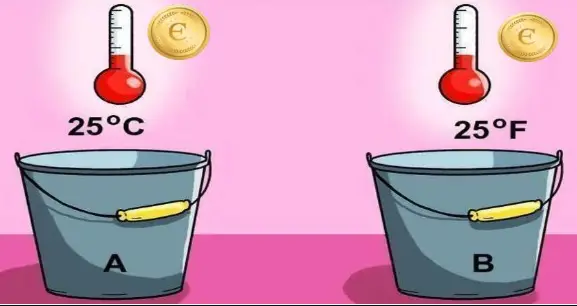Another fun puzzle that is intended for fans of such and similar puzzles. These puzzles are great for moving your brain, advancing your creative and logical thinking, and enhancing your visual abilities.
This is another logical task that will be fun to solve. Although it may seem like a difficult task, it is not, but you will realize it only when you come to the correct answer.
What is your task? Your task is related to coins and buckets. In this picture you will notice two buckets filled with water. Above the buckets you will notice the water temperature which in one bucket is expressed in Celsius degrees, and in the other bucket the water temperature is expressed in Fahrenheit degrees. In the first bucket the water temperature is 25 o C and the water temperature in the other bucket is 25 o F. Coins of the same height are placed in both buckets at the same time.
What is your task? Your task is to find the answer to the question of which coin will fall to the bottom first?
Try to find the answer to the question yourself. If you fail, you will find the answer below in the text.
The answer is in the first bucket.
Explanation of the answer. In the first bucket, the coin will be the first to reach the bottom. Why? The reason for this is that water is in a liquid state at 25 degrees Celsius, and at 25 degrees Fahrenheit the water turns to ice. Therefore, in the second bucket, the coin will not touch the bottom.
The Celsius temperature scale is named after its Swedish inventor Anders Celsius. Today 0 degrees is considered the freezing point of water and 100 degrees the boiling point.
The Fahrenheit temperature scale is named after its inventor Daniel Gabriel Fahrenheit. On this scale the degree of freezing of water is defined as 32 degrees, and boiling is defined as 212 degrees.
To implement the temperature values from Celsius to Fahrenheit and back there are special formulas: for example, temperature Celsius \ u003d (Fahrenheit temperature – 32) * 5/9. For example, 120 degrees Fahrenheit according to this formula would be equal to 48.9 degrees Celsius.
For the reverse translation, you can use the following formula: Fahrenheit Temperature \u003d Celsius Temperature * 9/5 + 32. For example, 20 degrees Celsius according to this formula would correspond to 68 degrees Fahrenheit. At the same time, both of these formulas can be used to transmit negative temperatures in Celsius on the Fahrenheit scale.

